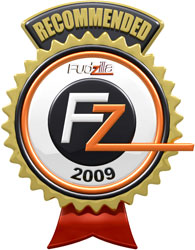Index


Review: Master of under-voltaging
This article is also available in German.
One week ago the first Lynnfield arrived to our labs. While we would have liked to give you all the results and conclusions the time was not enough. Instead we concentrated on the i5 750 which is the most promising due to it's price target at $199,- or roughly €175,- including taxes.
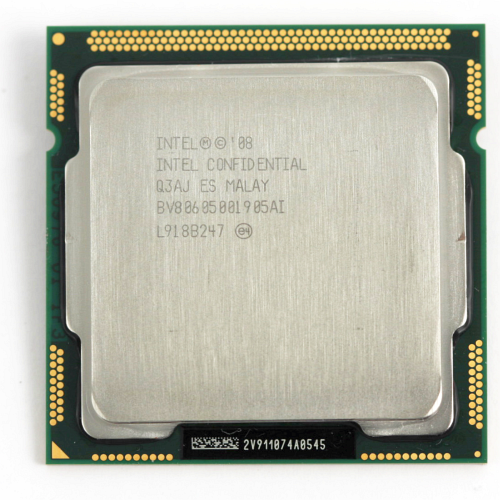
We did all the tests with the MSI P55-GD80 because we have good support from MSI, so BIOS bugs get fixed really fast. Roughly two weeks ago we introduced you to the mainboard which is really a high-end part. We do not like all the three slot designs due to the limitations of the PCH (Peripherial Controller Hub). While it does support PCIe 2.0 all the lanes run only with half the speed. So, if they say it's PCIe 2.0 x16 @ x4 this is wrong, because PCIe 2.0 stands for double the speed compared to PCIe 1.x, so in reality you get PCIe x16 @ x2 speed. That is not something to be proud of. Also the price of around €185 is a tad too hight, at least compared to the next model in line, the P55-GD65 which is only a bit downsized (less phases, one PCIe x16 less) but at very competitive €130 price.
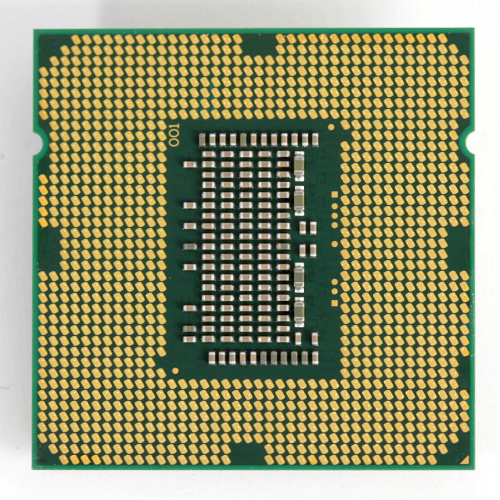
Of course the good thing is, the board is running fine in every environment, under-voltaging, normal and over-clocking - no problems at all. Also MSI did improve their BIOS big time. We always wanted to have default voltages either as setting or in the help screen. MSI decided to use the help screen. So you will always have a reference when overclocking. How to do so, we will explain later on.
Testbed:
Motherboard:
MSI P55-GD80 (provided by MSI)
Intel P55
MSI 790GX-GD70 (provided by MSI)
AMD 790GX/SB750
MSI DKA790GX (provided by MSI)
AMD 790GX/SB750
Gigabyte GA-EP45-UD3P (provided by Gigabyte)
Intel P45/iCH10R
Intel DX58SO "Smackover" (provided by Intel)
Intel X58/iCH10R
CPU:
Intel Core i5 750 (provided by Intel)
AMD Phenom II 705e (provided by AMD)
AMD Phenom II 905e (provided by AMD)
AMD Phenom II 720 Black Edition (provided by AMD)
AMD Phenom II 810 (provided by AMD)
AMD Phenom II 955 Black Edition (provided by AMD)
Intel E7200 (provided by K&M Elektronik)
Intel E8400 (provided by Intel)
Intel Q9450 (provided by Intel)
Intel QX9650 (provided by Intel)
Intel Core i7 920 (provided by Intel)
Intel Core i7 975XE (provided by Intel)
CPU-Cooler:
Scythe Kabuto (provided by Scythe-Europe) for AMD and Intel E/Q
Thermalright Ultra 120 eXtreme 1366 (provided by Thermalright) for Intel i7 9xx
Thermalright MUX-120 1156 (provided by Thermalright) for Intel i5
Memory:
Kingston 2GB Kit PC2-9600U KHX1200D2K2/2G (provided by Kingston)
1066MHz CL5-5-5-15 CR2T at 1.90V for AMD DDR2
Qimonda 3GB Kit PC3-8500U (provided by Qimonda)
1066MHz CL7-7-7-20 CR1T at 1.55V for Intel i7
Kingston 3GB Kit PC3-10600U KHX1600D3K3/2GX (provided by Kingston)
1333MHz CL7-7-7-20 CR1T at 1.50V for AMD DDR3 and Intel P55
1440MHz CL7-7-7-20 CR1T at 1.50V for Intel P55
1600MHz CL8-8-8-23 CR1T at 1.60V for AMD DDR3 FSB overclocking
1644MHz CL9-8-8-23 CR1T at 1.60V for Intel P55
1800MHz CL9-8-8-23 CR1T at 1.65V for Intel P55
Graphics Card:
MSI R4850-2D1G-OC (provided by MSI)
Power supply:
PC Power & Cooling Silencer 500W (provided by PC Power & Cooling)
Hard disk:
Samsung F1 1000GB (provided by Ditech)
Case fans:
SilenX iXtrema Pro 14dB(A) (provided by PC-Cooling.at)
Scythe DFS122512LS
Case:
Cooler Master Stacker 831 Lite (provided by Cooler Master)
OS:
Since we are still not fans of Vista, all tests are performed with XP SP3. As 64-bit software is still not very common, we stick with the 32-bit version.
As you know the i5-750 runs with 2.66GHz, has four cores, does not support hyperthreading and a TDP of 95W. Compared to the i7 900 series, they only change is the memory controller which is now only a dual-channel, which is not as bad as you may expect, and the integrated PCIe controller. Also the Turbo has been improved, for core one and two you get x24 = 3.20GHz instead of the standard x20. The third and forth run only with x21. The VCore default is 1.2000V. When using the higher turbo, the i7 920 will be left in the dust, because it does only turbo up to x22/x21/x21/x21.
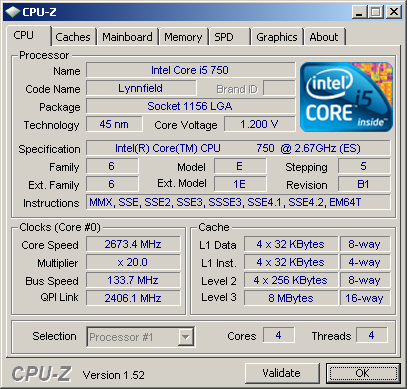
While Turbo mode is a nice feature for all users who don't want fiddle with overclocking settings, it will increase the performance especially with applications not optimized for multi-theading. But we guess everyone reading our site knows how to handle these things, so we don't really care about Turbo mode.
Overclocking:
As usual when overclocking you should disable the turbo, but ignore all the warnings about disabling EIST, Speedstep or any other energy saving settings. This is only necessary for extreme overclockers with liquid nitrogen. We only use an air-cooler, so let's check what it can do.
The first step is, how high does it get with not altering the voltages at all. Of course if you leave the BIOS settings to AUTO some boards as our MSI does set ridicilous values. We advise you to set all voltages to nominal settings manually. In our case CPU VCore 1.2000V, VTT/QPI 1.1000V, DDR3 runs with our modules fine with 1.5000V. We set BCLK to 180MHz and voilà you get to 3.60GHz. For some reason the board increases the VCore under load. We can't explain this behavior yet, but normally it should drop. Of course we tested with Prime95 and it run fine without any problems. We tested memory running with 1440MHz at CL7-7-7-20 and 1800MHz at CL9-8-8-23. As you will see, they perform quite equally.

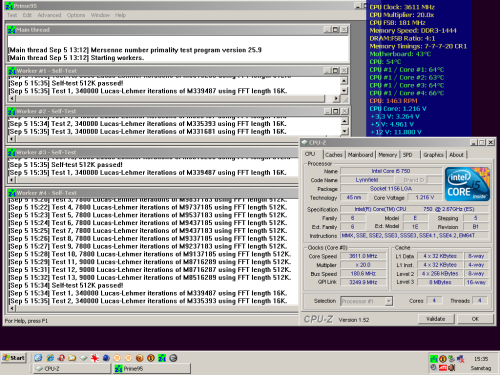
The next step was to go for the 4GHz which is a magical barrier. We upped the VCore to 1.3750V and VTT to 1.222V. With Turbo disabled, all cores run with this speed. Run like a charm.
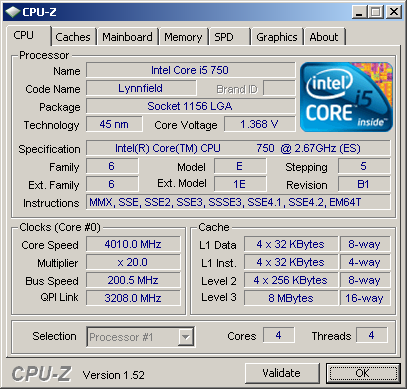
Of course we are not happy with that result, so we tried the next step, 4.1GHz. Yes it worked stable with air-cooling. That's not bad. VCore upped to 1.4000V, VTT to 1.270V. Trying 4.2GHz failed, it seems we hit a wall around 4.2GHz. Upping the voltage will not help, so if you want go higher, you need at least water cooling because also the core temperature are spiking over 90°C which is not recommended at all. Memory is running with 1644MHz. Please note that the sample CPUs will get higher compared to CPUs bought in the store because they are hand-picked for reviewers.
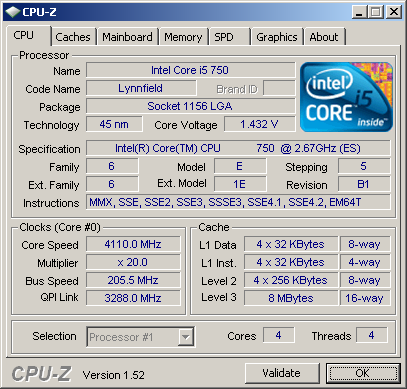
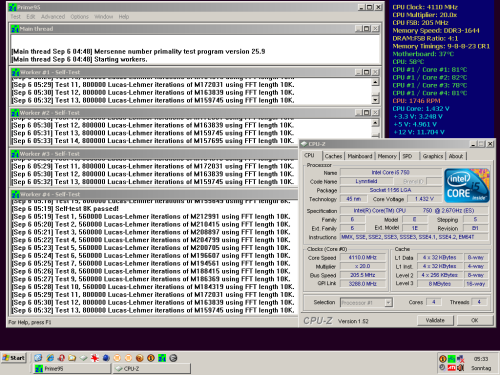
Under-Voltaging:
At least in Europe the market is shifting to a more "green" awareness. Getting most performance at the lowest possible energy cost does matter, because energy is expensive in western Europe. Lower voltaging will give you the same performance compared to the standard setting but shave off some bucks from your energy bill. With the Core i5/i7 series, you need to disable Turbo, of course Turbo will increase power consumption. We did not only lower the VCore to 0.975V, we also reduced the VTT to 0.965V. And can you believe it, the result was amazing. Again we checked the result with Prime 95, this time over night to make sure it works flawless.
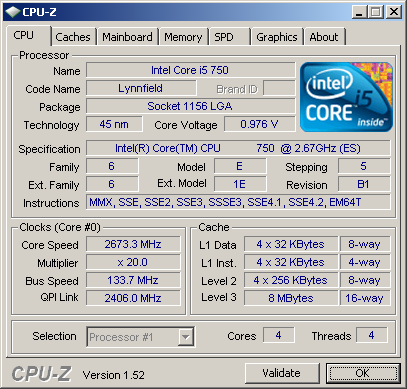
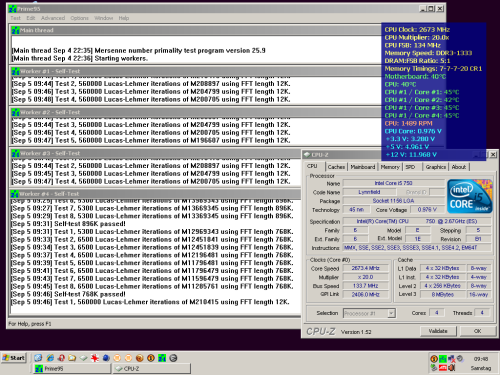
Our benchmarks are quite self-explanatory. Beside the usual benchmarks we included the Far Cry 2 Bench, which should show only the benefit of a faster CPU. As already explained for better comparison we only benched in non-HT mode and non-Turbo mode, to get comparable results on a clock to clock basis. Also note, we did some tests with C-States enabled (CS en) and C-States disabled (CS dis). C-State disabled gives higher performance but also increases power-consumption especially in idle-mode.

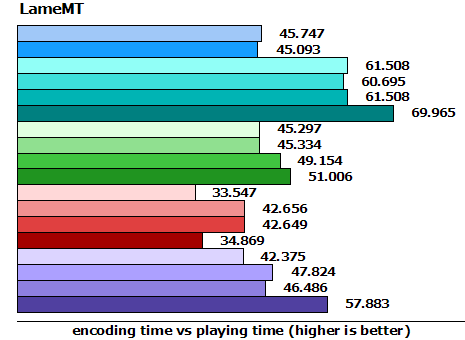
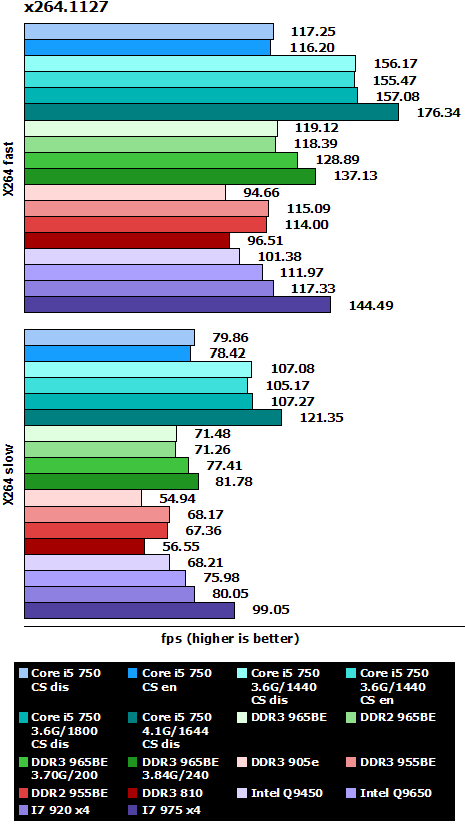
3DMark 2003 run at 1600x1200, 3DMark 2006 used defaults. As you can see, more CPU muscle doesn't really help. FarCry2 benching is a mess, the results vary quite a lot, the more often you do it the slower it gets. But anyway, the results are still quite close.
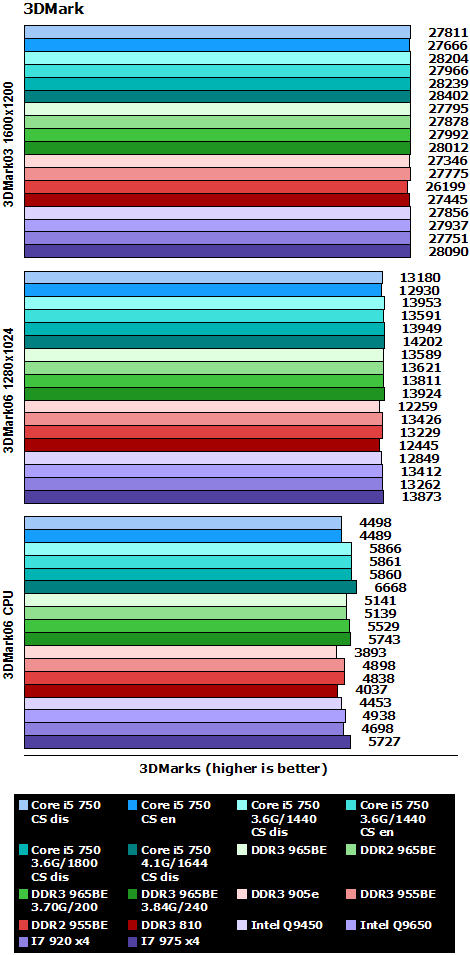
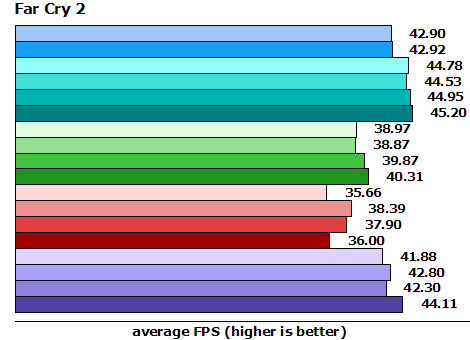
As usual our power-consumption test. This time you have to consider, all tests were done with C-States enabled (CS en) or C-States disabled (CS dis). The later prevents the CPU from going into "deep-sleep" which does increase the power-consumption especially in idle power. When under-voltaged about 20% the i5 750 is superb. This is the first time a Core i series chip can beat the previous generation, while we have to note, we did not test that.
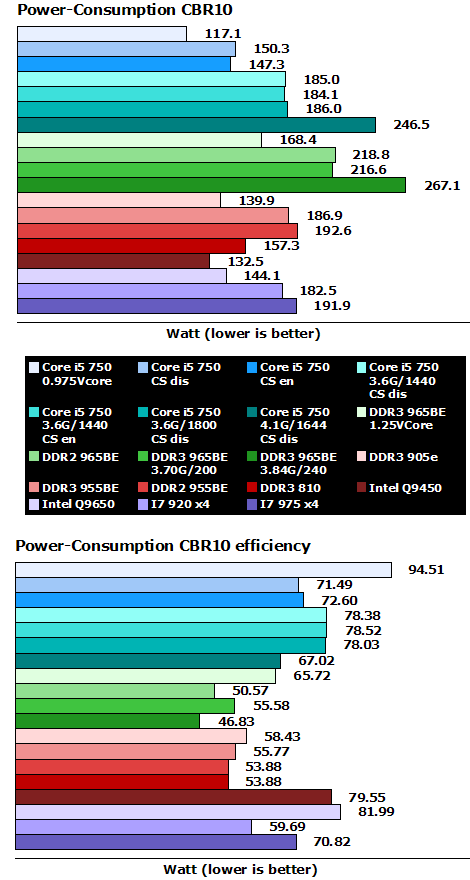
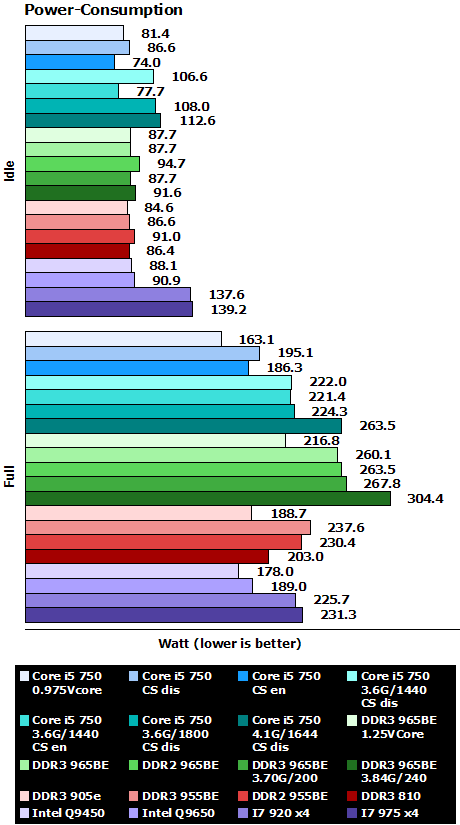
Before we can do a conclusion, again we give you the overall scores. As you can see the i5 750 is performing almost equally with the i7 920. If you consider the higher turbo, when enabled, then the i5 750 will win. The dual-channel memory interface does not limit the performance. The only "disadvantage" is the disabled Hyperthreading. We think Hyperthreading does not really matter for most consumers. Most applications can't do anything with it and in some applications it will even slow things down. That may change if Windows 7 can organize the cores better, we will see that shorty.

To give you a better overview we have a new chart. We calculated the cost of the used mainboards, CPUs and graphics-card and also the lowest possible price for a 4GB kit for dual-channel or a 3GB kit for triple-channel. Memory of course PC3-12800 (1600MHz) with CL8-8-8-24 and PC2-8500 CL5-5-5-18. So the overclocking memory settings may not apply but it gives you a good overview. The Q9450 is not any more available or at horrible high prices, so we used the Q9550 pricing. As we have written in our AMD Phenom II 965 Black Edition review this CPU is too expensive. You get the best price/performance ratio with an AMD Phenom II 955 Black Edition running on a DDR2 board.
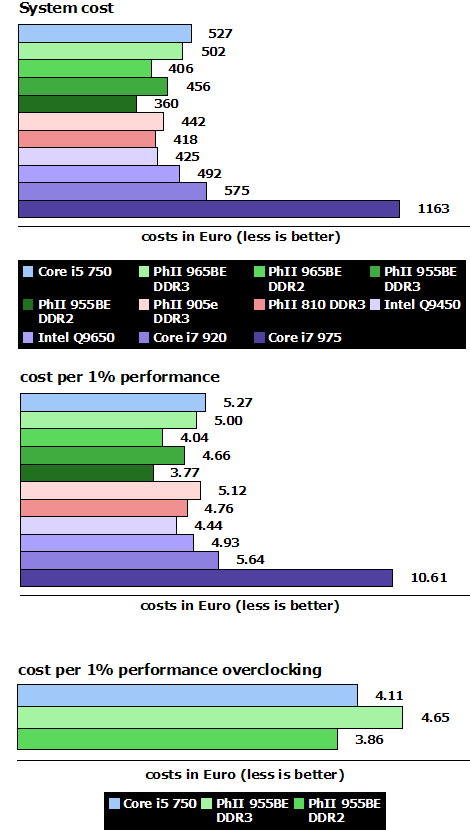
Conclusion:
The i5 is the first mainstream CPU based on the Nehalem architecture. While clock for clock the new CPU is faster compared to the Core 2 series and AMD's Phenom II, the new stepping comes close to the power-consumption of the older P45 platform and leaves AMD in the dust. That is also a huge improvement compared to the X58 platform. The CPU will set you back about €174,- that's €50,- less compared to the i7 920.
We also like the flexibility of this CPU. Buying a 2.66GHz CPU and getting over 4Ghz just with air-cooling is impressive. The most amazing is the high under-voltaging capability of this CPU. While you have to disable the turbo mode, you get the same speed with the highest efficiency we have measured yet.
The only problem for Intel is the high platform cost. While enthusiasts are gladly going for DDR3, AMD still has the advantage with its DDR2 platform in terms of value. Not only is the memory cheaper, but the mainboards are also much cheaper. A so called high-end board will set you back under €100,- while the same for the P55 will cost you now about €180,-. Also the integrated chipsets from AMD are miles ahead of Intel, so for office-machines an i5 would be overkill. We will have to see how the cheaper P55 offerings will do. Also the P45 boards are now well under €100,- and the performance is not that far off. For a standard user, who does internet and gaming the cheaper offers will suffice. But we bet the prices will go down and there is a new price war imminent. Intel did however render the i7-920 obsolete, because the i5-750 with Turbo enabled is the faster CPU and platform costs are much lower.
Intel has the upper hand performance wise but on a price/performance ratio AMD win with their DDR2 platform. For many enthusiasts the i5 is a better choice compared to any i7 and also HTPC users who want to use their machine also for gaming can benefit. Therefore, we can easily recommended it.
